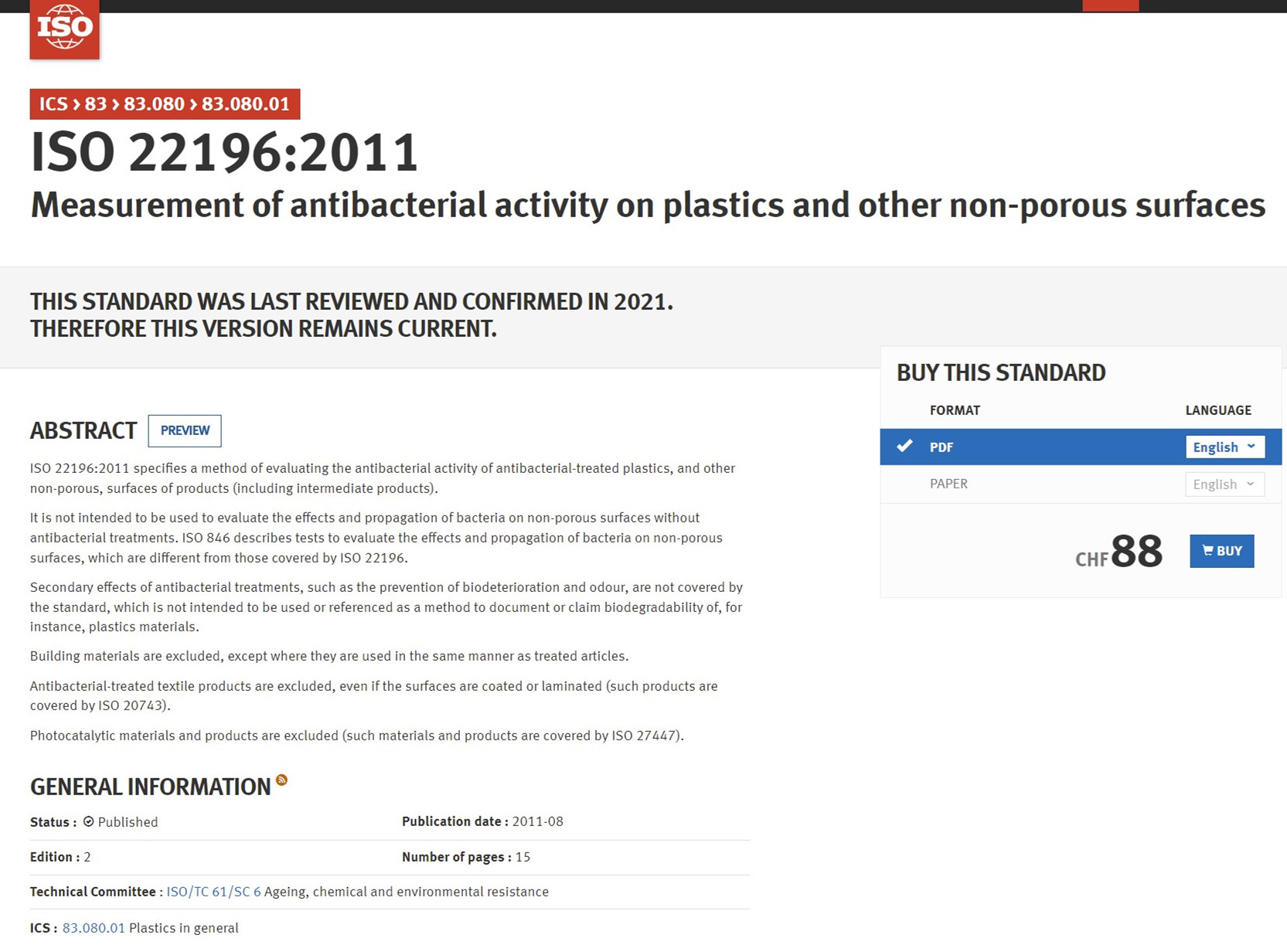塑料与其他无孔表面的抗菌性测定
时间:2015-04-16 22:00:14 来源:CIAA 点击量:

ISO 22196:2011
Measurement of antibacterial activity on plastics and other non-porous surfaces
Introduction
Antibacterial materials and products have been widely and rapidly accepted by general consumers as fulfilling a relatively new function, which is distinguishable from the more traditional function of material protection.
Antibacterial products created by incorporating an antibacterial agent (biocide) can suppress the growth of bacteria on the surfaces of products when conditions exist where growth can occur. They can keep surfaces clean and sanitary and can also have an advantage in minimizing the impact on the environment by minimizing diffusion of the agent. This technology is significant for the quality of life, not only in developed countries but also in developing countries.
Antibacterial products have been widely used in plastics, coating materials, ceramics, natural and artificial leather, stainless steel, rubber, etc. The products involved cover a variety of categories, such as electrical appliances, personal items, household goods, nursing-care articles, pet accessories and aircraft-interior fittings.
The scope of the first edition of ISO 22196 was limited to plastics surfaces. In this second edition, the scope has been extended to include surfaces made of other non-porous materials, thus making the second edition applicable to products of the kinds listed above. The test method, which is based on JIS Z 2801[11], has remained unchanged.
1 Scope
WARNING — Handling and manipulation of microorganisms which are potentially hazardous requires a high degree of technical competence and may be subject to current national legislation and regulations. Only personnel trained in microbiological techniques should carry out such tests. Appropriate practices for disinfection, sterilization and personal hygiene must be strictly observed.
This International Standard specifies a method of evaluating the antibacterial activity of antibacterial-treated plastics, and other non-porous, surfaces of products (including intermediate products).
It is not intended to be used to evaluate the effects and propagation of bacteria on non-porous surfaces without antibacterial treatments. ISO 846[1] describes tests to evaluate the effects and propagation of bacteria on non-porous surfaces, which are different from those covered by this International Standard (see e.g. ISO 846:1997, method C).
Secondary effects of antibacterial treatments, such as the prevention of biodeterioration and odour, are not covered by this International Standard, which is not intended to be used or referenced as a method to document or claim biodegradability of, for instance, plastics materials. In the case of plastics, biodegradation is covered in ISO 14851[2], ISO 14852[3] and ISO 14855[4] and related standards.
Building materials are excluded, except where they are used in the same manner as treated articles.
Antibacterial-treated textile products are excluded, even if the surfaces are coated or laminated (such products are covered by ISO 20743[5]).
Photocatalytic materials and products are excluded (such materials and products are covered by ISO 27447[6]).
The results obtained should include a reference to this International Standard and the conditions used. Results obtained with this International Standard indicate antibacterial activity under the specified experimental conditions used, and do not reflect activity under other circumstances where a variety of factors, such as temperature, humidity, different bacterial species, nutrient conditions, etc., have to be considered. A minimum diffusion of the antibacterial agents/chemicals into the test inoculum is necessary with this procedure.
It is recommended that workers consult ISO 7218.
2 Normative references
The following referenced documents are indispensable for the application of this document. For dated references, only the edition cited applies. For undated references, the latest edition of the referenced document (including any amendments) applies.
ISO 7218, Microbiology of food and animal feeding stuffs — General requirements and guidance for microbiological examinations
3 Terms and definitions
For the purposes of this document, the following terms and definitions apply.
3.1
antibacterial
term describing a state where growth of bacteria on the surfaces of products is suppressed or describing the effect of an agent which suppresses the growth of bacteria on the surfaces of products
3.2
antibacterial agent
agent that inhibits the growth of bacteria on the surfaces of products, used either as a surface treatment or as a compounded ingredient
3.3
antibacterial activity
difference in the logarithm of the viable cell counts found on an antibacterial-treated product and an untreated product after inoculation with and incubation of bacteria
3.4
antibacterial effectiveness
ability of an antibacterial agent to inhibit the growth of bacteria on the surface of materials treated with an antibacterial agent, as determined by the value of the antibacterial activity
CIAA会员单位免费下载
